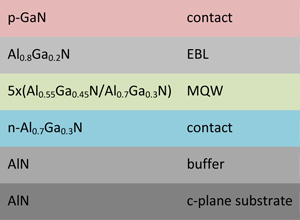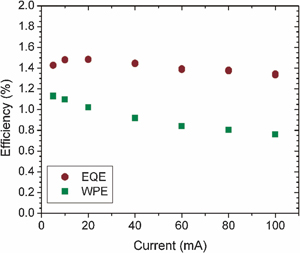- News
28 July 2011
Record output for single-chip 262nm mid-UV LED
Crystal IS Inc of Green Island, NY, USA and US Army Research Laboratory (ARL) claim record output power for single-chip ultraviolet (UV) light-emitting diodes with peak wavelength less than 265nm [James R. Grandusky et al, Appl. Phys. Express, vol4, p082101, 2011]. The researchers say that their measurement of 72mW at 1.7A of partial output power from a device emitting around 262nm corresponds to more than 100mW total when corrected for the fact that the set-up did not measure all the light coming out of the device.
The team comments: “The results presented in this letter are approaching the output power and efficiency needed to begin replacing current mid-ultraviolet sources in specialized applications.”
LEDs for the mid-UV range of 250–275nm are being developed with a view to the replacement of mercury-lamp systems that are bulky, fragile, contain hazardous material, and have long warm-up times. The first application in sight is mid-UV disinfection systems, where the light is used to kill microbes in water and on surfaces.
Other possible uses include biological analyses and other instrumentation. Near-UV LEDs between 300nm and 400nm are presently used for bio-detection because they produce much more power than the mid-UV devices developed so far, but shorter wavelengths are more efficient in showing up biological particles through fluorescence techniques.
As usual, the challenges for producing efficient LEDs center on the need for high-quality nitride semiconductor material with low defect density and high hole carrier density, and on efficiently extracting the light that is produced. For devices emitting wavelengths shorter than 275nm, external quantum efficiencies (EQEs) have so far been limited to less than 2%.
 The researchers used the same epitaxial material and fabrication techniques as in work carried out by Crystal IS in 2010 [James R. Grandusky et al, Appl. Phys. Express, vol3, p072103, 2010]. Metal-organic chemical vapor deposition (MOCVD) was used on AlN substrates to create the pseudomorphic (strained) epitaxial material (Figure 1).
The researchers used the same epitaxial material and fabrication techniques as in work carried out by Crystal IS in 2010 [James R. Grandusky et al, Appl. Phys. Express, vol3, p072103, 2010]. Metal-organic chemical vapor deposition (MOCVD) was used on AlN substrates to create the pseudomorphic (strained) epitaxial material (Figure 1).
Figure 1: Epitaxial structure used in UV LED.
The multi-quantum well (MQW) light-emitting region consisted of a 5-period structure of n-Al0.7Ga0.3N barriers and Al0.55Ga0.45N wells. The electron-blocking layer (EBL) was Al0.8Ga0.2N. The large 2.4% lattice mismatch of the final p-GaN layer with the pseudomorphic AlGaN was bridged by interrupting the growth and re-initiating in a Stranski–Krastanov mode where the first islands of GaN form that coalesce to create thick layers. This last layer therefore had a higher dislocation density (~1010/cm2) than the rest of the material.
An interdigitated mesa with an area of 0.0037cm2 and a maximum width of 100μm was etched in the 820μm x 820μm square chips using inductively coupled plasma. The n-contact consisted of titanium-aluminum-titanium-gold and the p-contact consisted of nickel-gold. Further processing consisted of flip-chip bonding to a patterned AlN ceramic submount with gold-tin solder, mounting on a copper stud in a lead frame package, and wire bonding to form the electrical contacts. A 48-hour burn-in process at 100mA was performed to weed out unstable, short-lifetime devices.
The turn-on voltage of the device ~5V was close to the ideal value of 4.7V. A quasi-continuous wave (CW) 400 millisecond measurement without heat-sink gave output powers of 2.1W at 20mA and 9.2mW at 100mA.
Further measurements in full CW and high current modes were made with a heat-sink. Unfortunately, the heat-sink was too big for the integrating sphere, so these measurements could not gather all the light emitted.
Comparing the output powers in CW on heat-sink operation with the quasi-CW at 20mA and 100mA gave ratios of 67.4% and 68.5%. The approximate constancy of this ratio suggests that the difference is due to light missing from the measurement without integrating sphere rather than from self-heating effects. Also, calculations based on the emission pattern of such LEDs suggest that ~73% of light should be collected without integrating sphere, which is close to the 67–69% measured.
Spectral measurements show a peak at 262nm with a full-width at half-maximum (FWHM) of less than 10nm for currents as low as 5mA.
 External quantum efficiency (EQE) and wall-plug efficiency (WPE) efficiency were also measured (Figure 2). The peak EQE was 1.48% at 20mA, falling off to 1.33% at 100mA. “The high EQE at low current densities is due to the low dislocation density in the material and the high IQE of the structures grown pseudomorphically on AlN substrates,” the team comments. The WPE peaks at the lowest current, being above 1% at 20mA and falling to 0.8% at 100mA. “The decrease in the WPE efficiency is due primarily to the decrease in electrical efficiency as the current is increased.”
External quantum efficiency (EQE) and wall-plug efficiency (WPE) efficiency were also measured (Figure 2). The peak EQE was 1.48% at 20mA, falling off to 1.33% at 100mA. “The high EQE at low current densities is due to the low dislocation density in the material and the high IQE of the structures grown pseudomorphically on AlN substrates,” the team comments. The WPE peaks at the lowest current, being above 1% at 20mA and falling to 0.8% at 100mA. “The decrease in the WPE efficiency is due primarily to the decrease in electrical efficiency as the current is increased.”
Figure 2: EQE and WPE from 5 to 100mA.
Pulsed measurements (100μsec, 0.5% duty cycle) in the same configuration as in CW testing (i.e. with heat-sink) were carried out up to 1.7A (Figure 3). The output power at 100mA was 6.5mW, an increase of only 3% over the CW case. This indicates good thermal management of the device for CW operation at these current levels. Increased current leads to less output power than one would expect from linear extrapolation (sub-linear). The researchers comment that such decreases in efficiency (droop) are seen in visible nitride LEDs.
 The highest output power was 72mW at 1.7A. Correcting for the absence of an integrating sphere would give an estimated output power of more than 100mW.
The highest output power was 72mW at 1.7A. Correcting for the absence of an integrating sphere would give an estimated output power of more than 100mW.
Figure 3: Output power as a function of current for the device operated in pulsed mode with a 100μsec pulse and 0.5% duty cycle.
The researchers also measured thermal characteristics of the device by placing the LED on a thermoelectric cooler that was operated in reverse to heat the junction up to 50°C. The characteristic temperature (Tc) for the reduction of power output with heating was 983K. A high value of this parameter indicates a slower fall-off in performance with heating. InGaN LEDs have achieved values up to 1600K, but up to now AlGaN LED devices emitting 265nm UV have been reported with values in the range 31–73K.
“The high Tc reported here is consistent with the fact that the pseudomorphic UV LEDs have both low dislocation density as well as good carrier localization in the quantum wells,” the researchers comment, adding, “The high characteristic temperature of 983K was instrumental in achieving these record output powers for an LED with wavelength shorter than 265nm.”
The work was partially supported by the US Defense Advanced Research Projects Agency (DARPA) under the Compact Mid-Ultraviolet Technology program, and in a Cooperative Agreement with ARL.
Crystal IS UV LEDs UV disinfection MOCVD AlGaN
The author Mike Cooke is a freelance technology journalist who has worked in the semiconductor and advanced technology sectors since 1997.
